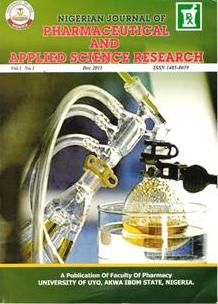Bioacaricidal properties of Passiflora edulis (Passifloraceae) vine methanol extract on two species of cattle ticks
Contenu principal de l'article
Résumé
Background: Cattle tick infestations, particularly those caused by Amblyomma variegatum and Argas argas, pose a significant challenge to livestock productivity in tropical regions. Overdependence on synthetic acaricides has led to widespread resistance, environmental pollution, and toxic residues in animal products, highlighting the need for safer, environmentally friendly alternatives. This study examined the bioacaricidal activity of Passiflora edulis (Passifloraceae) vine methanol extract against two economically important cattle tick species.
Methods: Fresh vines were collected, authenticated, shade-dried, ground, and soaked in absolute methanol. The crude extract was prepared in concentrations of 10, 20, 40, and 80 mg/mL, and applied topically (20 ?L) to groups of ten ticks per species in triplicate. Mortality was recorded over 24 hours, and results were analyzed using Two-way ANOVA followed by Dunnett’s post hoc test.
Results: The extract showed strong, concentration-dependent activity against both tick species. Complete mortality of A. variegatum was achieved at 10 mg/mL within 3 hours, while A. argas required 20 mg/mL to reach 100% mortality within 2 hours. At lower concentrations, mortality increased gradually, with significant differences (p < 0.001) compared to the control group.
Conclusion: These results represent the first report of acaricidal activity of P. edulis vine extract, emphasizing its potential as a sustainable alternative to synthetic acaricides in integrated livestock parasite control. Further research should focus on isolating active compounds, understanding their mechanisms, and conducting field validation.
Téléchargements
Renseignements sur l'article

Cette œuvre est sous licence Creative Commons Attribution - Pas d'Utilisation Commerciale - Pas de Modification 4.0 International.
Références
He X, Luan F, Yang Y, Wang Z, Zhao Z, Fang J, et al. Passiflora edulis: An insight into current research on phytochemistry and pharmacology. Front Pharmacol. 2020;11: 617.
Yi X, Huang DM, Liu Y, Bin W, Di C, Shun S. Identification of key genes involved in flavonoid and terpenoid biosynthesis and the pathway of triterpenoid biosynthesis in Passiflora edulis. J Integr Agric. 2023; 22 (5):1412–23.
Phamiwon Z, John S. Diabetes and medicinal benefits of Passiflora edulis. World J. Pharm. Res. 2015; 5(3): 453–65.
Zhang J, Koike R, Yamamoto A, Ukiya M, Fukatsu M, Banno N, et al. Glycosidic inhibitors of melanogenesis from leaves of Passiflora edulis. Chem. Biodivers. 2013; 10(10):1851–1865.
Nikolova K, Velikova M, Gentscheva G, Gerasimova A, Slavov P, Harbaliev N, et al. Chemical compositions, pharmacological properties and medicinal effects of genus Passiflora L.: a review. Plants. 2024; 13(2):228.
Mollong E, Lébri M, Marie-Magdeleine C, Lagou SM, Naves M, Bambou JC. Sustainable management of tick infestations in cattle: a tropical perspective. Parasit Vectors. 2025;18(1):62:1–10
Jamil M, Idrees A, Qadir ZA, Elahi ME, Imran F, Qasim M, et al. Medical and Veterinary Ectoparasites’ Importance: An Insight into Alternative Control. Pak J Med Health Sci. 2022;16(01):667.
Cruz RR, García DID, Silva SL, Domínguez FR. Integrated management of the cattle tick Rhipicephalus (Boophilus) microplus (Acari: Ixodidae) and the Acaricide resistance mitigation. In: Insecticides-Impact and Benefits of Its Use for Humanity. IntechOpen; 2021. Available from: http://dx.doi.org/10.5772/intechopen.100015
Githaka NW, Kanduma EG, Wieland B, Darghouth MA, Bishop RP. Acaricide resistance in livestock ticks infesting cattle in Africa: Current status and potential mitigation strategies. Curr Res Parasitol Vector-Borne Dis. 2022;2:100090.
Quadros DG, Johnson TL, Whitney TR, Oliver JD, Oliva Chávez AS. Plant-derived natural compounds for tick pest control in livestock and wildlife: pragmatism or utopia? Insects. 2020;11(8):490.
Ayinde BA, Okeke I, Ofeimun J, Imade R, Onakomaya O, Bamikole MA. Bioacaricidal effects of three volatile oils on cattle ticks. J. Pharm. Bioresour. 2022; 19(2): 58–65
Mar?i? D, Döker I, Tsolakis H. Bioacaricides in Crop Protection—What Is the State of Play? Insects. 2025;16(1):95.
Adenubi OT. Acaricidal efficacy of crude extracts and isolated flavonoids from Calpurnia aurea subsp. aurea against Rhipicephalus turanicus [PhD thesis]. Pretoria, South Africa: University of Pretoria; 2017; 1-214. Available from: University of Pretoria UPSpace repository.
Siame CP, Chitambo H, Muma JB, Choongo K, Moonga E. Field assessment of the efficacy of Tephrosia vogelii leaf extracts for control of ticks on naturally infested cattle in the field condition. J. Paras. Dis. 2019; 43(4):624–32.
Kosgei CJ, Matasyoh JC, Mwendia CM. Chemical Composition And Larvicidal Activity Of Essential Oil From Lippia javanica against Rhipicephalus appendiculatus larvae. J. Pharm. Biol. Sci. 2017; 12(6):46–9.


